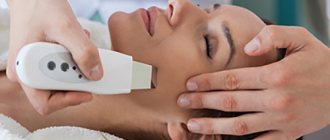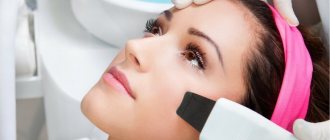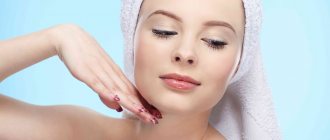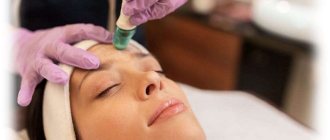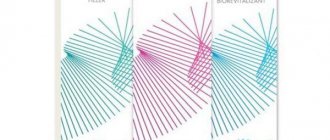In women, during menstruation, the oiliness of the skin increases, acne and inflammation appear, and the wrong type of cleansing can worsen the situation.
In addition, a few days before the onset of menstruation, the sensitivity of the epidermis increases and the chance of harmful microorganisms penetrating through the pores increases.
Types of facial cleansing
Cleaning is a serious procedure and must be carried out by a qualified cosmetologist in a special room. He examines the skin, assesses its condition, existing problems and wishes of the patient. At the same time, an experienced doctor will always ask what day of the cycle it is at the moment and clarify the tolerability of the procedures. After this, if necessary, he will select the most optimal type of cleaning and recommend proper aftercare.
There are several options:
- Manual cleaning . This is done after preparing and steaming the skin, in bright directional light and under a magnifying glass, using napkins. The doctor squeezes out comedones, acne and treats the face with antiseptics.
- Mechanical cleaning Prepared as in the manual method, the skin is precisely cleaned of impurities and inflammation using a special spoon or loop.
- Brossage (aka brushing) . Hardware technique. After preparing the skin and steaming, depending on the existing problems and tasks, various brush-like attachments are used (hence the name). Due to the mechanical movement of these brushes, pore impurities are eliminated and the skin surface is smoothed.
The first three methods primarily allow you to get rid of problems such as pimples, comedones, acne, blackheads, and milia. But at the same time they are traumatic and painful. They cannot be performed on irritated, inflamed skin, or if there are pustular elements on it. This threatens the spread of infection throughout the treated surface. After these procedures, the skin is injured and needs proper care. It includes treatment with antiseptics, skin cleansing, and the absence of decorative cosmetics.
These cleaning methods are also used as the first, preparatory stage before such effects on the skin as anti-aging procedures, injection and hardware treatments, peelings.
The following, more modern cleaning methods:
- Ultrasonic cleaning. Ultrasound has the ability to painlessly break down not only surface impurities, but also those located inside the skin pores. It breaks comedones and sebaceous plugs, allowing the contents to come out. Steaming the skin before this procedure is not required. Also a bonus will be the effect of improving blood circulation and metabolism in tissues.
- Vacuum cleaning. Requires prepared and steamed skin. A device with a nozzle creates a vacuum between it and the skin. Using the “vacuum cleaner” principle, all impurities and excess sebum come out of the pores in the direction of negative pressure. The procedure is painless and helps improve lymph and blood flow and smooth the skin surface.
- Disincrustation . This technique combines the effects of electric current and chemicals on the skin. First, with the help of certain conductors, the surface of the skin is exposed to current. At the same time, impurities and sebaceous plugs in the pores are broken down. The second stage is the application of active detergents, which enter into chemical reactions with sebum and remove it when washed off. The technique is also painless, safe and works very effectively on oily and problematic skin with a large number of clogged pores and inflammatory elements.
- Laser cleaning. A hardware technique with many advantages and a positive effect on the skin in general. In this case, there is no contact of the sensor-emitter with the skin, preventing its injury and the spread of infection. In addition to cleansing pores and smoothing the surface of the skin, anti-aging and anti-edematous effects are expressed. The complexion improves and evens out, and the pores become smaller.
- Dry cleaning . Special compounds (peelings) are applied to prepared, cleansed skin. The active ingredient in them is acids (fruit, salicylic or glycolic). Acid dissolves impurities and excess sebum, destroys the connection of dead epidermal cells with the skin. When carried out regularly, the procedure allows the skin to renew itself regularly and helps it regulate the functioning of the sebaceous glands. Perfectly evens out the tone and smoothes the surface of the skin, making it radiant. For a lasting and long-lasting effect, a course of several procedures is required. Their number is determined by a cosmetologist, based on the existing problems and assigned tasks.
Changes in the body during menstruation
During menstruation, there is a transition from the last phase of one menstrual cycle to the first phase of a new cycle. And in connection with this, the hormonal background undergoes serious changes. How does this affect the woman’s condition:
- A few days before and during menstruation, the sebaceous glands begin to work more actively, the skin becomes oilier, small rashes and acne appear. Therefore, the cosmetologist will ask you to reschedule many procedures.
- Immediately before or on the day of the onset of menstruation, fluid retention is observed in the body, and the tendency to edema increases. In this regard, it is better to postpone mesotherapy, biorevitalization and the introduction of fillers with hyaluronic acid for several days.
- During the entire 4-5 days during which menstruation occurs, a physiological decrease in blood clotting occurs. Therefore, with any invasive and injection cosmetology techniques, there is a high risk of hematomas and hemorrhages.
- Starting from the second phase of one cycle and increasing towards the beginning of the next, the pain threshold decreases. It becomes minimal 1-2 days before the start of menstruation and remains at this level for about a week. Accordingly, even those procedures that were previously easily tolerated can cause serious discomfort.
- Towards the end of the menstrual cycle and during menstruation, a woman begins to feel an emotional decline, tearfulness, and irritability. This condition can also negatively affect the course of the procedure and its result.
Popular questions
Good afternoon! Tell me, I was very praised for your Gynocomfort gel, but I’m a little confused, is it possible to use a cosmetic product internally - intravaginally?!?
Is it safe and legal? Hello! Gels from the Ginocomfort line are designed for use in the vagina and are safe and have therapeutic and prophylactic properties. Is it possible to gel when planning? Does it interfere with sperm (the antiseptic effect is scary).
Hello! This line of gels is not intended to create conditions for favorable conception. However, if you need to use lubricants during sexual intercourse, then Ginocomfort gel with mallow extract will not have a negative effect on sperm and can be used.
Hello! I used the gynocomfort gel with tea tree oil, and after a minute a strong burning sensation began. What could be the reason?
Hello! The cause of the burning sensation may be lactic acid, which is part of the product, or a reaction to other components of the product. A burning sensation is allowed for the first 30-60 seconds, after which the discomfort should stop. Then you can continue to use the product. If the burning sensation increases, it is better to stop using it to avoid an allergic reaction.
Immediately after the first use of the gynocomfort gel, abundant white and very thick discharge appeared. At the same time, I took tests a month ago - they were clean. And before use there was no discharge. I found many women on the forums who faced this problem. Tell me, what kind of side effect is this? Why is there not a word about it in the instructions and the main question is: if you stop using it, how quickly will the discharge state return to normal?
Hello!
The appearance of this kind of discharge in the form of “flakes” is a normal result of the interaction of the components of the product with the contents of the genital tract and will stop on its own after a few days. In this case, only external hygiene is required 1-2 times a day. For an accurate diagnosis, contact a specialist
How to properly carry out the procedure taking into account menstruation
If there is no opportunity to postpone the procedure, then you can minimize the discomfort.
- It is better to carry out the procedure itself from 8 to 10 am, when the body is at a high level of activity.
- Since the pain threshold is reduced, to make cleaning easier, you can take any non-steroidal anti-inflammatory painkiller (except aspirin, since it reduces blood clotting) - Ibuprofen, Nise, Paracetamol are perfect. In addition, they will have an additional anti-inflammatory effect.
- Before, during and after cleaning, antiseptic treatment is necessary. Otherwise, the inflammatory elements will take a long time to heal, and new ones may be added to them.
- After the procedure, you should not use cosmetics, but rather apply a cream that restores the skin to your face.
Precautionary measures
If laser hair removal occurs on critical days and it is impossible or inconvenient to reschedule the procedure, then you should pay attention to the following points:
- If you need to remove hair from your bikini area, practice good personal hygiene before your session and use a tampon instead of pads. This will ensure hygiene and comfort of the procedure, and will also help prevent negative consequences such as inflammation, infection, etc.
- Worry about pain relief. In the salon, the specialist will definitely treat the affected area with an anesthetic gel or cream. But during menstruation, such anesthesia may not be enough, so 20–30 minutes before the procedure, you can take any painkiller that will provide the most positive effect.
- After the procedure, be sure to follow the specialist’s recommendations, treat your skin with an antiseptic, and avoid thermal procedures, including sunbathing.
What types of cleansing are prohibited on critical days?
In fact, there are no medical prohibitions on cleaning procedures. Each woman must decide for herself which procedures are right for her, after consulting with a cosmetologist.
It is better to avoid the most traumatic types of cleaning such as manual and mechanical
. They can leave behind hematomas and acne spots that will take a long time to heal. Brushing can also injure the skin and increase the spread of infection.
It is not advisable to steam your face these days. After this, tissue swelling increases and the risk of hematomas increases. Therefore, cleaning methods that require this preliminary preparation are also undesirable.
Laser cleaning may cause prolonged swelling and redness of the skin after the procedure.
Features of laser hair removal during menstruation
Laser hair removal during critical days is carried out according to the usual scheme:
- Consultation with a cosmetologist, during which the doctor determines the scope of the intervention, assesses the condition of the skin, calculates the number of sessions required and the total cost.
- Preparing the area. The specialist treats problem areas with a local anesthetic and an antiseptic solution. To protect the eyes, the patient is given special glasses.
- Laser exposure. Using a laser device, a cosmetologist treats areas with unwanted vegetation.
What types of cleansing are allowed on critical days?
Optimal cleansing will be non-invasive in nature, that is, one that does not require violating the integrity of the skin. And ideally, completely contactless.
- Dry cleansing (peeling) with acids (except salicylic acid, which can increase facial swelling) can be done with caution. Glycolic and fruit acids in small concentrations will gently cleanse the skin.
- Disincrustation (here the current is applied without contact, and then the skin is treated with chemicals) is a painless and effective option these days.
- The most suitable cleaning method is vacuum. Contact with the skin is minimal, cleansing of contaminants occurs by sucking in air.
- Ultrasonic cleaning is also acceptable and easy to tolerate - it will help get rid of dirt on the surface and inside the pores completely painlessly. In addition, ultrasound stimulates metabolic processes and skin immunity, improves and evens out its color and surface.
Will there be any results from cleaning carried out on menstruation days?
The result of cleaning will be in any case, but not in all cases positive.
You need to be prepared for the fact that the result of cleansing will not last so long. Skin injuries will take longer to heal, and the number of acne and pustules may even increase over time. Post-acne spots and enlarged pores are more likely after cleansing.
In order for the result to please you and complications not to appear, the procedure must be carried out by an experienced cosmetologist in a cosmetology office. On critical days, it is better to do without home steaming and cleaning options, so as not to introduce an infection and not provoke the development of complications.
In which half of the cycle is it better to contact a cosmetologist?
The first half of the cycle, that is, the first two weeks after menstruation, excluding the first three days, is when it is better to cleanse your face before menstruation. At this time, complications are least likely to develop. After exposure to lasers, chemicals and instruments, the skin recovers faster, wounds, scratches, and burns actively heal, and the risk of secondary infection is reduced.
How to plan facial cleansing according to cycle periods
So, let’s summarize for all the days of the cycle, which on average lasts one lunar month, that is, 28 days.
- Days 1-5: These are the actual days of menstruation. Blood clotting is reduced and bleeding occurs. Often a woman experiences emotional instability or decline, weakness, decreased blood pressure, headache, abdominal pain, and lower back pain. Cleaning is extremely undesirable, as it will be painful, have a weak effect and cause complications such as hemorrhages, hematomas, tissue swelling, and increased inflammation.
- Days 6-16: During this time, before ovulation, the body prepares for pregnancy. The concentration of the hormone estrogen increases, which has a beneficial effect on the quality of the skin. Metabolic processes improve, as does blood and lymph flow, and the skin glows. The pain threshold is high, the woman experiences an emotional upsurge. It is on these days that the cleaning effect will be maximum. And its implementation will not cause pain.
- Days 17-21: Progesterone begins to predominate. It gives effects such as swelling, slower skin renewal, increased oiliness, sensitivity and a tendency to irritation and inflammation. The effect of the procedure becomes much weaker and unstable, and the risk of complications increases.
- Days 22-28: The effects of progesterone reach their maximum. It is highly undesirable to carry out cleaning these days. This will cause serious discomfort and will not give a good result. As an alternative, you can use gommage or a cleansing film mask. They will help smooth the surface and improve complexion. And inflammatory elements can be pinpointed with anti-acne products.
Ultrasonic facial cleansing (video):
Mechanical facial cleansing (video):
How to properly do hardware facial cleansing or brossage (video):
Cleaning during menstruation is not prohibited, but it is a very undesirable and risky procedure. There is a high chance of experiencing discomfort and not getting the desired effect from it. Home cleaning is not recommended these days.
If it is not possible to reschedule the procedure, you should give preference to the gentlest, non-manual methods of facial cleansing. And they should be performed only in special clinics by a cosmetologist.
Liked? Share with your friends!
Rules of intimate hygiene, video
is not responsible for the accuracy of the information presented in this video clip.
Source - JIt Zdorovo Sources:
- PUBLIC PERCEPTION OF MENSTRUATION AND TAMPON USAGE IN RUSSIA. Burina D. A., Burina E. A. // Interactive science. – 2016. – No. 6. – pp. 16-17.
- USE OF A MENSTRUAL CUP AS A PERSONAL HYGIENE PRODUCT FOR A MODERN WOMAN. Gorpenko A. A. // Problems of modern science and education. – 2022. – P. 80-83.
- Internal menstrual protection. Use of a safe and sanitary menstrual cup. Liswood R. // Obstet Gynecol. - 1959. - 13: P. 539–543.
- Menstrual hygiene: A neglected condition for the achievement of several millennium development goals. Ten VTA. // Europe External Policy Advisors. Oct. — 2007.
- Duet or menstrual protection. Averbach S. Sahin-Hodoglugil N. Musara P. Chipato T. van der Straten A. // A feasibility study in Zimbabwe. Contraception. - 2009. - 79: P. 463–468.





